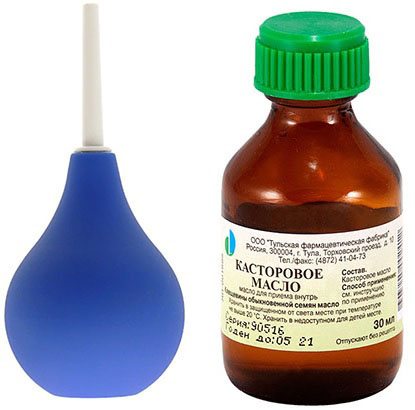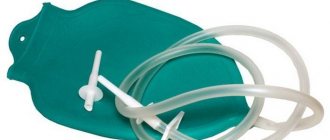Pharmacokinetic properties, indications, limitations
Castor oil can be purchased at pharmacies in the form of an oil solution and capsules.
Castor oil is often prescribed by gastroenterologists, dermatologists, and cosmetologists. The drug can be used in the treatment of stool retention for various reasons, as well as in preparation for intestinal examinations. If you drink castor oil, it is broken down by enzymes in the stomach and intestines. The active components of the oil begin to stimulate contraction of the walls of the intestinal tube. This leads to rapid excretion of feces. The effect occurs after about 5 hours (in some cases earlier).
Castor oil can also be used topically for skin wounds (burns, cuts, erosions). In dermatology, the drug is indicated for fungal infections of the scalp (dandruff), as well as for severe dryness of the skin. Cosmetologists advise using castor oil for baldness or poor hair condition, severe hair loss, slow growth and split ends. The drug enhances hair growth, relieves severe dryness and flaking of the scalp and body.
It is possible to use an enema based on Castor oil. It helps to gently cleanse the intestines of feces in 8-10 hours. The enema method does not cause discomfort to the patient, since there are no severe intestinal spasms. Castor oil simply facilitates the passage of intestinal contents. Oil enemas are very good for bedridden patients, as well as for children. You can use enemas for chronic constipation, when there is no stool for more than 1-2 weeks.
Indications for the use of an oil enema with castor oil:
- rapid cleansing of the intestine from harmful substances;
- bowel cleansing on the eve of gastric surgery;
- cleaning after surgery, childbirth;
- rapid recovery of burn wounds;
- together with general therapy of fissures and ulcerative lesions of the intestine;
- preparatory measures for examination on the intestines;
- the presence of restrictions on the cleansing enema, as well as its ineffectiveness.
You cannot use a little for an enema after surgery if there are wound surfaces and sutures. With Castor oil, the use of enemas is not indicated if there are oncological diseases of the intestinal tube. Acute intestinal diseases (appendicitis, colitis, proctitis) are a contraindication to enemas.
Enemas should not be used when the patient has intestinal and uterine bleeding, rectal prolapse, or bleeding fissures in the anus. An enema with castor oil is not indicated for patients with vascular and cardiac pathologies. An oil enema is not given to patients with a castor oil allergy.
Content
This term has other meanings, see
Of course, when you switch to a healthy diet, the need for periodic enemas decreases.
An enema is not given for acute inflammatory diseases in the anus, bleeding hemorrhoids, tumors in the decay stage, acute colitis, gastric and intestinal bleeding.
Purification with laxatives (as described by Ar Eddar) N
Along with enemas, laxatives are widely used for cleansing. But if enemas act on the large intestine, actively washing out compressed feces, then laxatives cleanse mainly the small intestine, although, of course, the large intestine is also freed. But still, the masses stuck to the surface of the colon are removed to a lesser extent than with enemas, since there is always a more or less free passage in the middle of the colon.
There are different types of laxatives. For effective one-time cleansing (for example, before fasting), magnesium (or Barbara salt, or bitter Epsom salt) is widely used.
Dissolve 30 to 50 grams of salt (about two-thirds of a tablespoon) in 500 ml of water. Water at room temperature or lukewarm. Any mineral water works very well.
Drink salt only on an empty stomach. After a light meal, at least 5-6 hours should pass.
Preparatory activities for an oil enema
To do an enema, you should purchase a syringe. For adults, you can buy a special bulb with a plastic tip (50 ml, 100 ml). For newborns you will need the smallest pear No. 1. For babies up to 6 months old, you can use syringe No. 1 or 2. For a child 6-12 months of age, syringe No. 3 or 4 is suitable. After a year, you can use larger syringes - No. 5 and 6.
For an adult you need to purchase 50-100 ml of castor oil. You should buy 250 ml at once so that it is enough for several procedures. A 30-50 ml bottle is enough for a child. Castor oil is sold in pharmacies without a prescription.
To perform an enema, you need to prepare a solution. The oil can be used pure or diluted. If you need to dilute the oil, then for an adult you will need 100 ml of water and 45 g of castor oil. You also need Vaseline or vegetable oil to perform an enema. The tip is lubricated with Vaseline, which makes it easier to insert.
Nutrient enema
A nutritional enema is the administration of nutrients through the rectum. This is one of the types of artificial nutrition, since meat broth, cream, proteins, amino acids, vitamins, alcohol, isotonic sodium chloride solution, and glucose solution are absorbed in the lower part of the large intestine. The volume of the nutritional enema should not exceed 200 g.
For the procedure you need:
- rubber can with a capacity of 200 g;
- petrolatum;
- spatula (wooden stick for Vaseline);
- nutrient liquid.
To perform a nutritional enema you should:
- 30-40 minutes before performing a nutritious enema, do a cleansing enema until the intestines are completely empty;
- heat the injected liquid to 38-40 °C;
- You should draw liquid into the can until 1-2 drops of liquid appear from it;
- lubricate the end of the can with Vaseline;
- place the patient on his left side with his knees bent;
- Having collected the nutrient liquid into the bottle, remove the air until the liquid appears outside, gradually pressing on the bottle;
- spread the patient's buttocks;
- insert the end of the can into the rectum;
- Gradually, under slight pressure, squeeze the liquid out of the can until it is completely empty and remove the end of the can;
- after the enema, treat the anus area;
- leave the patient lying in bed for about 1 hour. If the urge to stool appears, recommend that he breathe deeply through his nose.
Rules for the procedure
With Castor oil, an enema is often performed at home or in a hospital. If the procedure is carried out in a hospital setting, then a nurse is involved in preparing and administering the enema. An enema can be given at home by a relative, a nurse (nurse) or the patient himself.
The required amount of castor oil or an oil-water solution heated to body temperature is taken into the syringe (adults 50-100 ml, children up to 50 ml depending on age). A warm solution helps relax the intestinal walls and prevents intestinal spasms. Lubricate the tip of the syringe with oil or Vaseline. You need to squeeze out excess air from the syringe so that it does not worsen the process of cleansing the intestines.

The patient should be placed on his left side. The patient's legs should be bent at the knees, pulling them towards the stomach. Before inserting the tip, it is necessary to spread the buttocks. The tip of the syringe is inserted 5 cm into an adult. First, the tip is inserted 1-2 cm towards the navel, and then it is turned parallel to the sacrum.
This method of administration reduces the likelihood of discomfort and damage to the intestinal mucosa. After inserting the tip, castor oil is squeezed into the intestinal cavity by pressing on the bulb. Without opening the bulb, the tip is removed from the anus. The syringe after the procedure must be washed with soap and boiled for 15 minutes.
After administering the enema, the patient should lie down for 15 minutes or more (2 hours). It is better to do cleansing enemas with Castor oil before bedtime so that the effect of therapy is greater. If the patient stands or sits immediately after the enema, the oil will leak out. The urge to defecate appears after 8 hours (sometimes after 12 hours).
Carrying out the procedure in children under 12 months
To give an enema to a child under 1 year old, it is better to take the smallest size syringe (No. 1). Its tip is small and quite soft. Castor oil is diluted with water or used in its pure form. Before using castor oil, it is better to conduct an allergy test the day before the enema. A small amount of oil is applied to the child’s skin and the reaction is observed for 12-24 hours. If no rash appears, then you can perform a castor oil enema.
For children, it is better to dilute castor oil with boiled water. Dosages for children of different ages should be checked with a doctor. The volume of oil enema solution should not exceed 50 ml. Draw a solution into a syringe and lubricate the tip with oil or petroleum jelly. To carry out the procedure, a diaper is laid on the changing table and the baby is placed on it. The baby should be placed on his left side, with his legs bent towards his stomach. The procedure can be performed lying on your back with your legs bent and pressed to your stomach. This makes it easier to hold the baby’s legs if no one is helping to hold the baby in place.
The air from the syringe must be released, the tip must be inserted into the anus 1 cm, and then slowly press the bulb. Almost all babies begin to strain during the introduction of oil or water, so you should be prepared for the fact that the child will create resistance when introducing the solution. After insertion, the syringe should be slowly removed from the anus. The child's legs need to be straightened, the buttocks immediately pressed against each other and held for several minutes. After the procedure is completed, the baby should be dressed and put to bed, having previously been attached to the breast or fed with formula.
Microclyster
It is usually performed with a syringe, or, more simply, with a rubber bulb. Volume from 30 to 200 ml. It is performed mainly for the administration of medicinal solutions. A cleansing enema is first given to empty the rectum.
In pharmacies you can also buy a microenema that has a laxative effect (Microlax). It contains substances that are not absorbed by the intestinal mucosa (sodium citrate, sorbitol solution, sodium lauryl sulfoacetate, glycerol). The active ingredients of microenemas displace bound water from feces, stimulate intestinal motility, and also increase the flow of fluid into the intestinal lumen. Thanks to this, in a short time (5-15 minutes), the stool softens and constipation is resolved. The convenience of this device is that an adult, if necessary, can independently use a microenema to resolve constipation.
The administration of the drug will take only a few seconds and will not cause inconvenience or discomfort. It should also be remembered that the drug helps to empty the intestines, but does not eliminate the very cause of constipation.
To normalize all processes in the body, you should pay attention to the diet of the smallest family member and make nutritional corrections. The menu must include vegetables and fruits, vegetable oil, kefir and yogurt. You should also develop a certain routine, putting your baby on the potty at the same time. It is best to do this in the morning.
Be sure to monitor the amount of fluid your child consumes. Between meals you should give him weak tea, compotes, water or juices.
Hypertensive enema
To set it up, use 5-100 ml of 10% sodium chloride solution or 20-30% magnesium sulfate solution, heated to 37-38 °C. Bowel movement occurs within 20-30 minutes. These enemas not only increase intestinal motility, but also cause abundant fluid secretion into the intestinal lumen, which leads to large stools.
Performing a hypertensive enema involves the same steps as an oil enema.
≫ More information on the topic: https://www.meduhod.ru/components/medical_treatment/klismy.shtml
Source: live-excellent.ru
During pregnancy
During pregnancy, problems with stool often worsen, and natural bowel movements become difficult for several reasons:
- weak motor activity;
- increased levels of progesterone, which relaxes muscles, including the colon;
- eating disorders;
- exacerbation of chronic diseases;
- compression of the intestinal walls by the growing uterus and the growing fetus in it;
- exacerbation of hemorrhoids.
An oil enema, designed to promote the passage of stool, is possible during pregnancy, but undesirable. It can be carried out in consultation with a doctor after other methods have been tried to no avail, and only if there are no contraindications.
Contraindications for performing an enema during pregnancy may include:
- weakness or simply feeling unwell;
- headache;
- nausea and vomiting;
- even a slight increase in temperature;
- stomach ache;
- exacerbation of any chronic diseases;
- vaginal prolapse.
When performing an enema, there is a high probability that the uterus will become toned, which in the early stages can cause a miscarriage.
Milk enema
for constipation and flatulence: how to carry out the procedure?
How to do a cleansing enema at home? Read here.
Instructions for micro-enema Normakol - https://vashjeludok.com/lekarstva/raznoe/klizma-normakol.html











